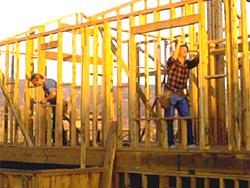Single-Family Home Construction Spurred by Covid Has Slowed
Washington, DC, December 7, 2022-The big jump in single-family home building activity that occurred in the aftermath of the Covid-19 pandemic in large metro outlying counties and exurban areas has shown a marked decline over the past 12 months, according to the latest findings from the National Association of Home Builders (NAHB) Home Building Geography Index (HBGI) for Q3 2022.
“The single-family construction slowdown is not just limited to regions of the country that experienced the fastest production growth over the past year,” said NAHB chairman Jerry Konter, a home builder and developer from Savannah, Georgia. “Home building activity has slowed in nearly all regions and large and small metro markets as high mortgage rates, elevated inflation and stubbornly high construction costs act as a drag on consumer demand and housing affordability.”
“While the bulk of single-family construction continues to occur in the South and lower density markets where job conditions are more favorable and housing costs are lower, the data clearly show these areas are acting as a leading indicator for the entire housing market,” said NAHB chief economist Robert Dietz. “They are registering the largest production declines, even as other regions-including large metro core and suburban counties-are also displaying weakness as the national housing market has fallen into a recession due to rising mortgage rates and a slowing economy.”
The HBGI is a quarterly measurement of building conditions across the country and uses county-level information about single- and multifamily permits to gauge housing construction growth in various urban and rural geographies.
The index shows that large metro outlying counties (exurban areas) registered the largest 12-month decline in single-family production, falling from a 31.9% growth rate in the third quarter of 2021 to a minus 4.4% rate in the third quarter of 2022. Smaller metro outlying counties also saw a significant deceleration, registering a 30.6% percentage point drop for its growth rate during the same period. Urban core areas in both large and small metro areas also posted negative growth rates during this time frame.
Rural counties, including micro counties and non-metro/micro counties, were the only counties to post a positive year-over-year growth rate.
However, the multifamily market tells a different story, as the HBGI’s submarkets in multifamily home building showed the following increase in growth between the third quarter of 2021 and the third quarter of 2022 for large and small markets as metro area economies reopened following covid-era restrictions:
Multifamily construction in large metro suburban counties increased from an 18% growth rate to a 27.5% rate, and large metro core counties experienced a 7.1 percentage point increase.
Large metro outlying counties decreased from a 44.1% growth rate to a 31% rate.
Other key findings from the third quarter HBGI show that building activity continued to shift away from centralized markets toward more outer, smaller areas:
* From Q1 2020 to Q3 2022, the marketshare for single-family home building in large metro core and inner suburbs fell from 44% to 41.3%.
* In contrast, single-family home building in outer suburbs and exurban areas in large and medium sized metros has increased from 18% to 19% during the same time frame.
* Despite the recent uptick, high density multifamily construction in large metro core areas registered a similar decline during this two-and-a-half-year period, falling from 41% to 38.4%.
